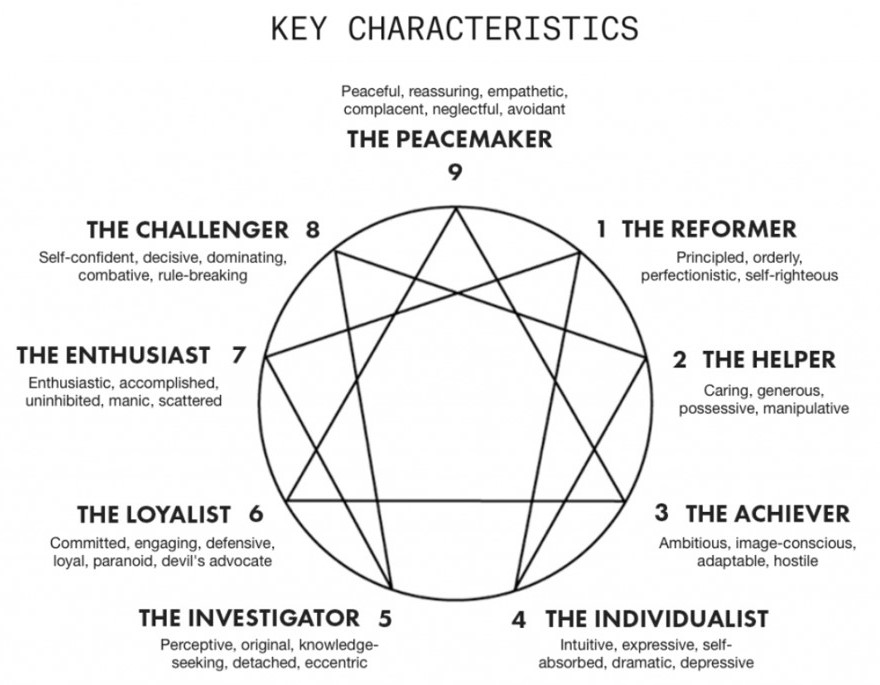What is the Enneagram?
The Enneagram is a holistic personality framework for understanding oneself and others. It is based on wisdom and experiential knowledge from many different psychological traditions and spiritual philosophies. Some theories and principles on which the Enneagram rests can be traced back to the ancient Greeks (Socrates and the Neoplatonists). Similar to the Enneagram, these traditions also “divided” people into nine main groups of certain personal characteristics and perspectives. From the mid-20th century, the Enneagram began to develop into the modern psychological model of today, based on the dedicated work of many individuals. The two persons who have been central for the development of today’s Enneagram framework are Oscar Ichazo and Claudio Naranjo, both originating from South America. Because the Enneagram has been developed through research, clinical work and studies of many different experts and centers, no person or organization can claim its ownership, nor is anyone its “founder”. For the same reason, the Enneagram also continues to develop, in terms of its depth, complexity, and understanding of the human. There are a few different narratives, but all are based on the same key elements and the overall structure, including the nine-headed symbol.
The nine personality types of the Enneagram
In essence, the Enneagram describes nine different personality types (sometimes also called strategies). Each personality type (or strategy) has its particular characteristics, in terms of general behaviors, desires, preferences, fears, and challenges. Thus, each personality type displays a certain habitual way of thinking, feeling and acting. Although each person will recognize him- or herself to some extent in ALL personality types, ONE personality type will feel most representative or well-reflective of one’s own unique personality. Thus, the Enneagram indicates how we tend to act out of pure habit, but also how we tend to act under stress, as well as how we may choose to act when we become more conscious of our tendencies.
Under stress, we are influenced by our “Stress-point”
Each person tends to adopt certain stress-induced behaviors, which are not typical for the type under “normal” conditions. Instead, these stress-induced behaviours are general features characteristic of another Type in the Enneagram. This other type is called our “Stress-point” or “Direction of disintegration”. For example, Type 7 tends to adopt certain stress-related behaviours that are generally associated with Type 1. Thus, Type 1 is the “stress-point” or “direction of disintegration” for Type 7. Thus, Type 7 may become irritable, self-critical and perfectionistic under stress; all of these charactersitics are general tendencies for a Type 1 personality.
When aware, we are influenced by our “Support-point”
Similarly, each person may adopt certain favorable or “supportive” behaviours that are more characteristic for another type. These supportive behaviours are thus not part of our habitual way of being or acting; yet, they can be fostered over time and become integrated within our personality as we grow in self-awareness and ability to be “present in the here and now”. The type, in which we find such favorable qualities for our own type, is called our “Support-point” or “Direction of integration”. For example, Type 7 can consciously choose to adopt favorable behaviours typical for Type 5, making Type 5 the “Support-point” (or “Direction of integration”) for Type 7. More specifically, Type 7 can choose to foster an ability to feel contentment with his/her understanding, as opposed to seeking to “fill one self up” with more ideas and knowledge.
Influenced by one of two “wings” (the types on each side)
Meanwhile, each personality type also has two so-called “wings”, which are the personality types on each side of one’s own type (on the Enneagram symbol). This means that your personality can be more or less influenced by the specific type on your left or right wing. For example, Type 7 may have a 6 wing or an 8 wing, which means that it shares certain qualities with either Type 6 or Type 8. Thus, depending on which is the most dominant wing for you, your personality will exhibit slightly different qualities. (The dominant wing can sometimes vary over your lifetime depending on your life circumstances.)

